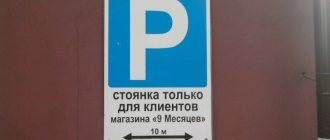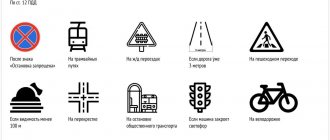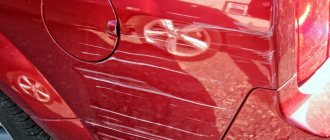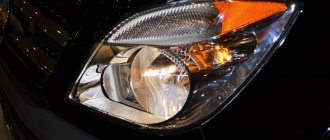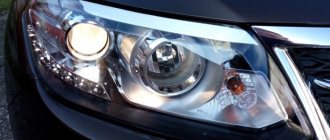Hello, dear readers. Today we will fully examine the topic of xenon on a car from the legal side. Let's look at the punishment for xenon, talk about what to do if you are stopped by an inspector with xenon and how to install truly legal xenon on any car.
The light emitted by xenon has characteristics similar to daylight, so the outlines of objects can be seen much more clearly. The visibility created by xenon in any weather conditions does not create unnecessary visual strain; rays of xenon light pass through drops of rain or fog and completely illuminate the road surface. The xenon light beam is much wider than usual, which, of course, improves the visibility of objects on the side of the road. Xenon emits twice as much light as a halogen lamp while consuming half the energy. The service life of xenon lamps is 2800-3000 hours. The service life of halogen lamps is 180-500 hours.
Gas-discharge xenon lamps began to be used in car headlights in 1992. They have greater light output and lower energy consumption than halogen and incandescent lamps. However, due to the design features of xenon lamps, they cannot be used in headlights designed to install traditional types of lamps. Simply replacing a halogen lamp with a xenon lamp leads, first of all, to dazzling oncoming and passing drivers, which is certainly a threat to road safety. Therefore, the current legislation of the Russian Federation provides for administrative liability for the use of external lighting devices that do not meet the requirements and design of the vehicle.
To begin with, let us turn to the clarifications on the use of “Xenon” headlights provided by the Road Safety Department of the Ministry of Internal Affairs of the Russian Federation dated February 20, 2010.
Currently, the following officially approved types of headlights are installed on vehicles:
– C – low beam, R – high beam, CR – dual-mode (low and high beam) light with incandescent lamps (UNECE Rules No. 112, GOST R 41.112-2005); – HC – low beam, HR – high beam, HCR – dual-mode light with halogen incandescent lamps (UNECE Rules N 112, GOST R 41.112-2005); – DC – low beam, DR – high beam, DCR – dual-mode light with gas-discharge light sources (UNECE Rules N 98, GOST R 41.98-99).
Explanations of the Ministry of Internal Affairs of the Russian Federation dated February 20, 2010
The approval mark is depicted in the form of a circle with the letter “E” inside, followed by the number of the country that granted the approval, as well as the number of the approval itself. Such a sign, together with the corresponding headlamp marking, is applied to the headlamp lens or to its housing if the lens can be separated.
The category of halogen incandescent lamps has a designation on their base or bulb that begins with the letter “H”.
Gas-discharge light sources (including xenon) , the category marking of which, indicated on the base, begins with the letter “D” , in accordance with the requirements of UNECE Regulation No. 99
and
GOST R 41.99-99 “Uniform regulations concerning the official approval of gas-discharge light sources for use in officially approved gas-discharge optical elements of motor vehicles”
are intended for use only in headlights of types
DC, DR, DCR.
Based on clarifications from the Federal State Unitary Enterprise “Research and Experimental Institute of Automotive Electronics and Electrical Equipment” (NIIAE)
the use of light sources in external lighting devices that do not correspond to the type of the given lighting device violates the conditions for ensuring road safety due to a number of physical (dimensions of the spark discharge, wavelength, scattering angle of reflected radiation) and technical (class of the reflective surface of the reflector, presence on the vehicle automatic light beam corrector and headlight washer) factors.
Thus, the use of gas-discharge light sources in headlights intended for use with incandescent lamps, including halogen ones, should be qualified as a discrepancy in the operating mode of external lighting devices (a set of technical characteristics of headlights corresponding to a particular light distribution that ensures road safety depending on road situation and weather conditions) to the requirements of the vehicle design.
Responsibility
In answer to this question, I would like to note the following: it just so happens in Russia that the burden of proving guilt no longer lies with traffic police officers in the event of going to court to resolve a controversial situation. From now on, it is you who will have to prove your innocence; the courts, as a rule, have little understanding of all the intricacies of this issue and in most cases take the side of the traffic police officers.
So, what is the fine for xenon in 2021? And are they deprived of their rights for xenon? Illegally installed xenon is a malfunction in which the operation of the vehicle is prohibited.
Light fixtures do not have lenses or use lenses and lamps that do not match the type of light fixture.
Clause 3.4 of Chapter 3 of the List of faults
Driving a car with unauthorized xenon lamps installed in headlights not intended for their installation entails deprivation of the right to drive a car for a period of six months to a year with confiscation of these lamps and devices for their operation (Part 3 of Article 12.5 of the Code of Administrative Offenses of the Russian Federation). Just like that, but there is no fine - you immediately lose your license for xenon.
Driving a vehicle on the front of which are installed lighting devices with red lights or red reflective devices, as well as lighting devices, the color of the lights and the mode of operation of which do not comply with the requirements of the Basic Regulations for the admission of vehicles to operation and the duties of safety officials road traffic (as amended by Federal Law No. 210-FZ of July 24, 2007) entails deprivation of the right to drive vehicles for a period of six months to one year with confiscation of the specified devices and accessories. (Part 3 introduced by Federal Law dated July 22, 2005 N 120-FZ)
Part 3 of Article 12.5 of the Code of Administrative Offenses of the Russian Federation
Devices for operating xenon lamps are devices designed to ensure their functionality (ignition units and other equipment directly servicing the operation of xenon lamps).
Glow temperature
To determine the shade that will characterize the glow of the headlight, the temperature of the luminous flux is used. It is measured in Kelvin. The white type of glow is as close as possible to daylight rays. Therefore, it is as familiar to the eye as possible.
When deciding which H4 lamps with white light to choose, you need to pay attention to the temperature indicator. It will indicate what shade of white light the lamp will emit. To do this, you need to pay attention to the temperature range designed for these products.
If the driver wants to get a tint-free color emitted by the headlights, he must purchase a 5000-5500 K lamp. This is the most pleasing color to the eye. White light with a yellow (warm) tint is emitted by devices 4000-4800 K. Blue or blue (cold) color is inherent in lamps 5500-8000 K.
Installing LED headlights: different options
From a legislative point of view, the installation of diode headlights will make a fundamental difference in the following cases:
- Factory installed LED headlights. Certification of lighting equipment is carried out by the manufacturer himself; the buyer does not need to worry about anything.
- Installation of LED headlights that are standardly installed on the vehicle by the manufacturer. Re-registration with the traffic police will be required; approval of the installation is not required.
- Installation of LED headlights when the manufacturer did not provide for this type of headlights. Installation approval and re-registration with the traffic police will be required.
Let's consider the last two options, since the first does not require additional explanation.
Installing LED bulbs in halogen headlights
Let's say you are the owner of a regular car with halogen optics, and you want to install LED lamps instead of halogen ones. Let's consider this situation from the point of view of traffic regulations. As you know, car headlights are always made for a specific type of lamp, and are marked accordingly. For example, if you install a xenon lamp in a headlight designed for halogen lamps, we will get a significant “flare” around the edges - the reflector is designed for an almost point source of light at the desired point, while the xenon lamp is a cylinder filled with luminous gas. Therefore, precise focusing of the light flux does not occur, and such headlights will always blind oncoming drivers and everyone around.
So is it possible to install LED bulbs in halogen headlights?
No, since this leads to the implementation of paragraph 3.1 of the Appendix to the Traffic Regulations “List of faults and conditions under which the operation of vehicles is prohibited”
List of faults, clause 3.1. The number, type, color, location and operating mode of external lighting devices do not meet the requirements of the vehicle design.
The punishment for this violation is provided for in Part 1 of Article 12.5 of the Code of Administrative Offenses:
Code of Administrative Offenses of the Russian Federation, Art. 12.5 h 1 . Driving a vehicle in the presence of malfunctions or conditions under which, in accordance with the Basic Provisions for the admission of vehicles to operation and the duties of officials to ensure road safety, operation of the vehicle is prohibited, with the exception of malfunctions and conditions specified in parts 2 - 7 of this article , - entails a warning or the imposition of an administrative fine in the amount of five hundred rubles.
Thus, the maximum fine for installing LED light bulbs is 500 rubles. How will an inspector check the type of headlights on a car? It’s very simple - according to the factory markings on the headlight glass. We talked more about headlight markings in the article Are xenon lamps allowed?
Is it possible to install LED headlights instead of halogen ones?
If we talk about replacing entire headlights with ones designed for LED lamps, then such a conversion is usually possible. We are talking about the re-equipment of a car, which is carried out in accordance with the Technical Regulations of the Customs Union “On the Safety of Wheeled Vehicles”:
75. Verification of compliance with the requirements for vehicles in operation in the event of changes to their design is carried out in the form of a preliminary technical examination of the design for the possibility of making changes and subsequent verification of the safety of the design and technical inspection of the vehicle with changes made to the design .
During the preliminary technical examination, it is ensured that after changes are made to the design of the vehicle, its compliance with the requirements of these technical regulations that were in force at the time the vehicle was put into circulation will remain. During the safety check of the vehicle design, it is ensured that after changes are made to the design of the vehicle, its safety meets the requirements of these technical regulations.
Types and classification
Based on the type of energy consumed, lamps are divided into:
- mains voltage 220 W;
- low voltage up to 24 W.
Low-voltage models are installed in the head light, instrument panel, and side lights. To illuminate the torpedo, a capsule version with leads is used.
The lamp design includes a reflector, a reflector of standard sizes MR8, MR11 and MR16. Light emission is transmitted to the road at different angles.
The question of whether it is possible to install halogen lamps on a car is incorrect in principle. Since 1980, automotive lighting of this class has been used by all world manufacturers for cars of various price segments. Optics for cars have the following varieties:
- Increased brightness. Provides road illumination up to 120 meters.
- Increased power. A standard lamp is designed for an optimal power of 50-55 W. Some companies offer auto lamps with a power of up to 130 W.
It is prohibited to turn on halogen headlights with a power of more than 60 W on public roads.
- All-weather models. They are distinguished by yellow light and are used for installation in fog lights.
Structurally, such headlights can be separate or connected. By type of reflectors used:
- For low beam - ellipsoidal or free-form.
- For distant lights - parabolic and free-form.
The position of the headlight and the adjusted beam of light are maintained by an electromechanical corrector.
When can LED headlights be installed?
If LED headlights are installed on a car by the manufacturer, then installation of such headlights can be carried out according to a simplified scheme. No examination will be required to determine whether such a conversion is possible in principle. It will be enough to make a replacement in a workshop certified for such work and register the conversion with the traffic police. This is evidenced by paragraph 77 of section 4 of chapter V of the technical regulations of the customs union:
77. Vehicles are not subject to inspection in the following cases: 1) when installing components on a vehicle: intended for this vehicle and having passed the conformity assessment as part of this vehicle, which is confirmed by the documentation of the component manufacturer; provided by the vehicle manufacturer in the operational documentation; 2) when serial changes are made to the design on the basis of design documentation developed and approved in the prescribed manner, if on its basis an assessment of the conformity of the changes made was carried out.
That is, the checks specified in clause 75 of the Customs Regulations will not be required in this case.
Installation
During operation, the device heats up to 500 °C. When installing, do not touch the glass with your hands; it is better to wear textile gloves or use rags.
Installation on a car is carried out with or without removing the headlight. If replacement occurs through dismantling the headlight, the order of work is as follows:
- The mounting bolts are loosened.
- The headlight is removed from the body.
- The power connector is disconnected.
- The protective cover is removed (turn counterclockwise), designed to seal the device.
- The metal clasp holding the headlight is released by pressing upward.
- The light bulb is removed from the headlight and replaced with a new one.
- It is recommended to remember the location of the contacts on the base: the new part is inserted into the same contacts.
The models continue to be the most popular for automotive lighting due to their affordable price and large selection.
Is the crossing allowed for fishing?
There was a serious uproar around the article Catching catfish with a line. The popularity is incredible.
